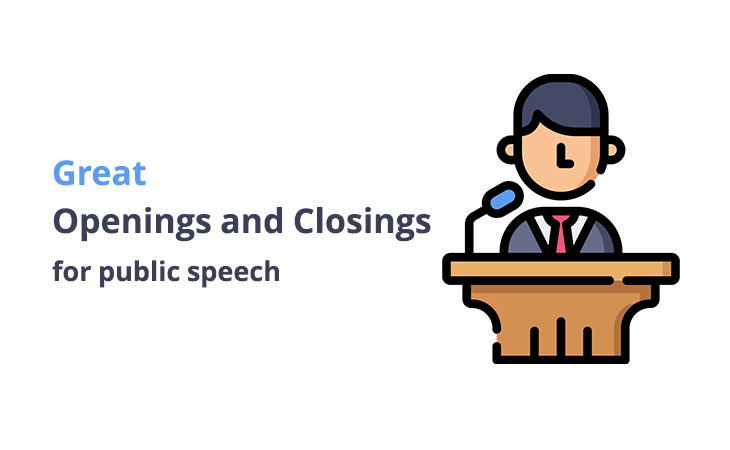
Here the best tips tools and techniques of Great Openings and Closings for Presentation to help people present with more polish power and professionalism.
The skills that I will be sharing with you are based on our own experience in instructing hundreds of thousands of speakers around the world I hope that you will find them as helpful as they have and I thank you for the opportunity to work with you.
Hello and thank you so much for having me I’m delighted to be here what a beautiful day it is and I am so happy to be sharing it with all of you.
when it comes to opening a presentation what I’ve just said is completely acceptable extremely polite and totally predictable that’s right the typical opening remarks that most speakers make are benign and boring they signal to the audience that what they are about to hear is nothing new or innovative or even interesting because even if you’re getting ready to share the most incredible news in modern medicine you have already lulled your audience into complacency so what separates the powerful passionate introductions from those that are merely polite it’s about capturing your audience’s attention the moment you begin to speak and then keeping their attention throughout along with getting attention a good opening also establishes your believability and credibility within the first minute of your presentation, you need to establish why you are the person to be delivering this message to this audience at this time of course if you have someone to introduce you to your audience before you begin to speak you can have thatperson highlight your personal and professional credentials but if it’s left up to you, you might need to list a few carefully selected highlights which can be expressed directly such as this example I have a nursing degree from the University of Michigan and I’ve spent the past seven years working inthe critical care unit of New York’s Lenox Hill The hospital you can also share your credentials indirectly through storytelling such as in this example over the past seven years in my role as a critical care nurse at New York’s Lenox Hill Hospital I have seen my share of trials and tribulations but whether you take the head-on approach or a more roundabout way you’ll need to let your the audience know the answer to why you in addition to gaining attention and establishing credibility.
your opening also needs to speak to the the audience’s with them what am with them wi i FM this stands for what’s in it for me whether we like to admit it or not we’re all self-interested as listeners we pay attention to those things that feel personally and professionally relevant useful and pressing and ignore the rest so a good opening establishes early on what about today’s presentation is going to be relevant useful and pressing to this audience if the audience isn’t compelled to care they’re going to be looking for their first opportunity to tune you out and it’s your job to get them interested and invested when making an introduction you’ll want to consider how much time you have a good guideline is that your the introduction should take up about two to three minutes of the presentation time especially if you have a significant amount of content to follow the relationship that you and your audience may or may not have at the start is also a factor for consideration a smart way to get started is to pull the room asking how many people are and p’s LPNs social workers or other allied professionals you might then ask who else is in the room with professions you haven’t mentioned and be welcoming of them as well by knowing who is in the room, you can ensure that your examples and information is aimed at your audience and their clinical expertise you also want to think about your audience’s relationship to your not just to you if your listeners are already positively inclined to act on your message then your introduction can take that into account if you have a mixed opinion audience or a resistant audience you may want to address this upfront such as I know that today’s topic may bring up a number of questions from you and I want to let you know that I will address as many as I can in the time that we have today that puts the audience at ease and when the audience is relaxed you can relax too finally, you’ll want to consider your natural style when planning an introduction here are some possible ways to start your presentation off on the right foot no matter what the topic is asking a question either one that calls for a response or a rhetorical one asking the audience a question forces them to start thinking it’s creating an opening that they want need to fill use today’s date if you happen to be speaking on the anniversary of 9/11 you need to acknowledge it if you happen to be speaking on the day before everyone is leaving for Thanks giving vacation you need to acknowledge it when there’s something generally known about today’s date your introduction provides an appropriate opportunity for you to address something that you and your audience share which is exactly how you can build rapport well I can tell you that setting high expectations at the beginning of your presentation is the key to establishing rapport connection and credibility with your audience and once you get them rooting for you the rest of your presentation will go a lot more smoothly of course all good things must come to an end and your conclusion is where you make sure that you have left your audience feeling positive and with a clear call to action a great conclusion recaps the main points of your presentation brings the topic to a natural satisfying close includes a call to action when appropriate and lets the audience know once and for all that you and they are done too often, we put plenty of time and thought into our introductions and the body of our presentation but we don’t plan for our wrap-up sometimes we run out of time or energy in the planning phase and this bleeds into the presentation where we simply run out of time or energy in the delivery isn’t it a shame to have put so much work into your presentation only to leave the audience remembering your fizzle out at the end that’s a rhetorical question by the way a the technique you can use not only in the opening but in the closing as well your audience may likely remember best what you said last.
do you want them to remember you saying uh I guess that’s it do you want them to remember you coming to your conclusion and then discovering you had a few more points to make on previous slides I bet not as a polished presenter, you want your audience to remember you being in control of yourself your content and your time to the very end you also want your audience to remember what you said and what you want them to do without any confusion or delay make sure that you present your final slides with power polish and professionalism and with a positive tone to leave your audience feeling positive about you and your message.
Resource:










